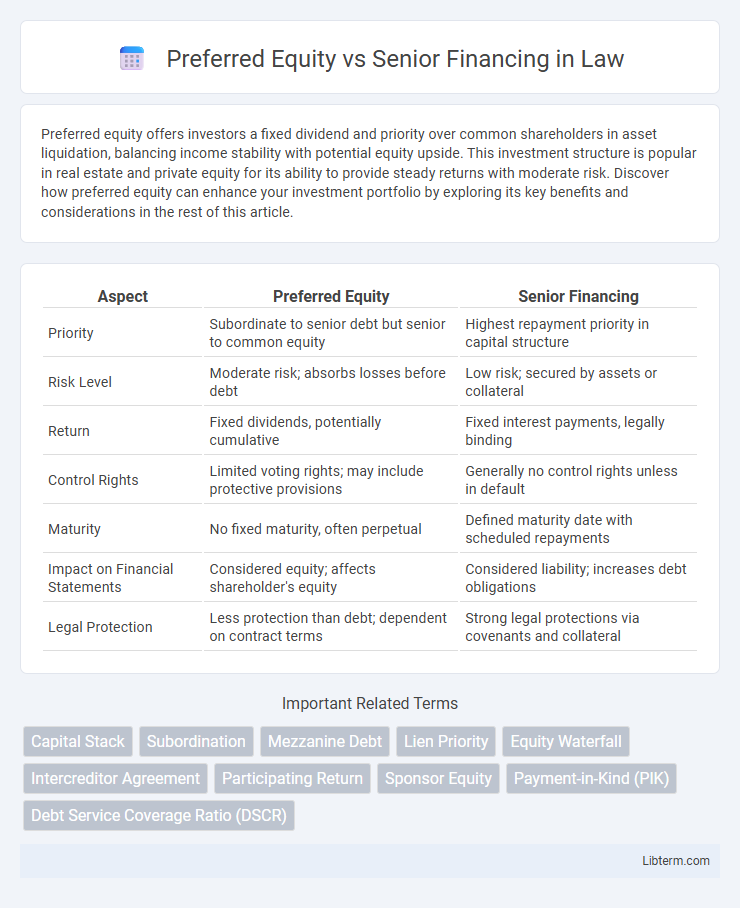Preferred equity offers investors a fixed dividend and priority over common shareholders in asset liquidation, balancing income stability with potential equity upside. This investment structure is popular in real estate and private equity for its ability to provide steady returns with moderate risk. Discover how preferred equity can enhance your investment portfolio by exploring its key benefits and considerations in the rest of this article.
Table of Comparison
| Aspect | Preferred Equity | Senior Financing |
|---|---|---|
| Priority | Subordinate to senior debt but senior to common equity | Highest repayment priority in capital structure |
| Risk Level | Moderate risk; absorbs losses before debt | Low risk; secured by assets or collateral |
| Return | Fixed dividends, potentially cumulative | Fixed interest payments, legally binding |
| Control Rights | Limited voting rights; may include protective provisions | Generally no control rights unless in default |
| Maturity | No fixed maturity, often perpetual | Defined maturity date with scheduled repayments |
| Impact on Financial Statements | Considered equity; affects shareholder's equity | Considered liability; increases debt obligations |
| Legal Protection | Less protection than debt; dependent on contract terms | Strong legal protections via covenants and collateral |
Introduction to Preferred Equity and Senior Financing
Preferred equity represents a hybrid financing option offering investors fixed dividends with higher claim priority than common equity but subordinate to debt, providing companies flexible capital without increasing debt load. Senior financing consists of secured debt instruments with the highest repayment priority in a capital structure, typically involving lower interest rates and stringent covenants to protect lenders. Understanding the distinctions in risk, cost, and claim priority between preferred equity and senior financing is crucial for optimizing a company's capital structure.
Key Differences Between Preferred Equity and Senior Financing
Preferred equity represents an ownership stake with dividend priority but subordinate claim on assets compared to senior debt, which is a loan secured by collateral and has the highest repayment priority. Senior financing typically involves fixed interest payments and strict covenants, while preferred equity offers higher risk tolerance with potential for equity upside but limited control rights. The choice between preferred equity and senior debt hinges on the investor's risk preference, return expectations, and the borrower's capital structure flexibility.
Structural Hierarchy: Where Each Stands in the Capital Stack
Preferred equity occupies a subordinate position below senior financing in the capital stack, ranking higher than common equity but lower than senior debt in claims on assets and cash flows. Senior financing holds the top priority, ensuring repayment before any distributions to preferred equity holders during liquidation or cash flow events. This structural hierarchy impacts the risk-return profile, with senior financing offering lower risk and returns, while preferred equity demands a higher yield due to its subordinated claim.
Return Profiles: Yield Expectations for Investors
Preferred equity typically offers higher yield expectations than senior financing due to its subordinate position in the capital stack and increased risk exposure. Senior financing provides lower, more stable returns as it holds priority claim on assets and cash flows, minimizing investor risk. Investors targeting enhanced yield often accept the preferred equity's greater volatility in exchange for potential upside beyond senior debt returns.
Risk Assessment: Understanding Default and Recovery Scenarios
Preferred equity carries higher risk than senior financing due to its subordinate claim on assets during default, resulting in lower recovery rates for investors. Senior financing typically offers lower risk with first priority claims, leading to higher potential recovery in default scenarios. Risk assessment should emphasize the capital stack position, repayment priority, and historical recovery outcomes to accurately gauge potential losses.
Control and Governance Rights
Preferred equity holders typically receive limited control and governance rights compared to senior financing lenders, who often hold significant influence through covenants and enforcement mechanisms. Senior financing agreements grant lenders priority claims and the ability to impose specific operational restrictions to protect their interests. In contrast, preferred equity investors generally participate in governance primarily through board representation or voting rights tied to particular terms, offering them some influence without overriding control.
Typical Use Cases in Real Estate and Corporate Finance
Preferred equity is commonly used in real estate for bridging capital gaps where developers seek subordinated financing with fixed dividends, providing flexibility without diluting ownership. Senior financing dominates corporate finance and real estate acquisition financing due to its lower risk profile and priority claim on assets, often structured as term loans or mortgages. Typical use cases for senior debt include acquisition loans, project financing, and operational capital, while preferred equity is favored for mezzanine financing, recapitalizations, and dividend recap deals.
Impact on Borrower’s Balance Sheet and Financial Flexibility
Preferred equity improves a borrower's balance sheet by increasing net equity without adding debt, enhancing debt-to-equity ratios and reducing leverage risks compared to senior financing. Senior financing increases liabilities, leading to higher leverage and potential constraints on future borrowing capacity due to stricter covenants and fixed repayment schedules. Preferred equity offers greater financial flexibility by providing capital without mandatory amortization, while senior debt requires regular principal and interest payments that can strain cash flow and restrict operational decisions.
Legal and Documentation Distinctions
Preferred equity involves ownership interests with priority over common equity but subordinate to senior debt, reflected in shareholder agreements detailing dividend rights, liquidation preferences, and voting restrictions. Senior financing is governed by loan agreements, promissory notes, and security documents establishing creditor rights, collateral claims, covenants, and default remedies. Legal distinctions rest on control mechanisms and risk hierarchy, with preferred equity holders receiving equity protections under corporate law while senior lenders enforce contractually stipulated repayment terms secured by assets.
Choosing the Right Option: Factors to Consider
Preferred equity offers flexible repayment terms and profit participation, making it ideal for businesses prioritizing growth without immediate cash flow constraints. Senior financing provides lower interest rates and priority claim on assets, suiting companies seeking lower-risk, cost-effective capital. Key factors include risk tolerance, capital structure impact, repayment ability, and long-term business goals.
Preferred Equity Infographic

 libterm.com
libterm.com